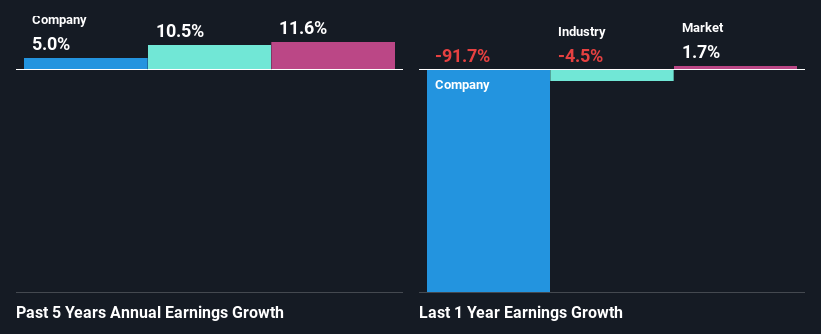Marks Electrical Group PLC's (LON:MRK) Stock is Soaring But Financials Seem Inconsistent: Will The Uptrend Continue?
Marks Electrical Group's (LON:MRK) stock is up by a considerable 8.1% over the past month. However, we decided to pay attention to the company's fundamentals which don't appear to give a clear sign about the company's financial health. Particularly, we will be paying attention to Marks Electrical Group's ROE today.
Return on equity or ROE is a key measure used to assess how efficiently a company's management is utilizing the company's capital. In short, ROE shows the profit each dollar generates with respect to its shareholder investments.
View our latest analysis for Marks Electrical Group
How To Calculate Return On Equity?
The formula for return on equity is:
Return on Equity = Net Profit (from continuing operations) ÷ Shareholders' Equity
So, based on the above formula, the ROE for Marks Electrical Group is:
3.1% = UK£427k ÷ UK£14m (Based on the trailing twelve months to March 2024).
The 'return' is the yearly profit. That means that for every £1 worth of shareholders' equity, the company generated £0.03 in profit.
What Has ROE Got To Do With Earnings Growth?
We have already established that ROE serves as an efficient profit-generating gauge for a company's future earnings. Depending on how much of these profits the company reinvests or "retains", and how effectively it does so, we are then able to assess a company’s earnings growth potential. Assuming all else is equal, companies that have both a higher return on equity and higher profit retention are usually the ones that have a higher growth rate when compared to companies that don't have the same features.
Marks Electrical Group's Earnings Growth And 3.1% ROE
It is hard to argue that Marks Electrical Group's ROE is much good in and of itself. Even compared to the average industry ROE of 7.7%, the company's ROE is quite dismal. Therefore, the disappointing ROE therefore provides a background to Marks Electrical Group's very little net income growth of 5.0% over the past five years.
Next, on comparing with the industry net income growth, we found that Marks Electrical Group's reported growth was lower than the industry growth of 10% over the last few years, which is not something we like to see.
The basis for attaching value to a company is, to a great extent, tied to its earnings growth. The investor should try to establish if the expected growth or decline in earnings, whichever the case may be, is priced in. This then helps them determine if the stock is placed for a bright or bleak future. Is Marks Electrical Group fairly valued compared to other companies? These 3 valuation measures might help you decide.
Is Marks Electrical Group Making Efficient Use Of Its Profits?
Marks Electrical Group's low three-year median payout ratio of 20% (or a retention ratio of 80%) should mean that the company is retaining most of its earnings to fuel its growth. However, the low earnings growth number doesn't reflect this as high growth usually follows high profit retention. So there could be some other explanation in that regard. For instance, the company's business may be deteriorating.
In addition, Marks Electrical Group only recently started paying a dividend so the management must have decided the shareholders prefer dividends over earnings growth. Based on the latest analysts' estimates, we found that the company's future payout ratio over the next three years is expected to hold steady at 21%. Still, forecasts suggest that Marks Electrical Group's future ROE will rise to 25% even though the the company's payout ratio is not expected to change by much.
Conclusion
On the whole, we feel that the performance shown by Marks Electrical Group can be open to many interpretations. Even though it appears to be retaining most of its profits, given the low ROE, investors may not be benefitting from all that reinvestment after all. The low earnings growth suggests our theory correct. With that said, the latest industry analyst forecasts reveal that the company's earnings are expected to accelerate. To know more about the latest analysts predictions for the company, check out this visualization of analyst forecasts for the company.
Have feedback on this article? Concerned about the content? Get in touch with us directly. Alternatively, email editorial-team (at) simplywallst.com.
This article by Simply Wall St is general in nature. We provide commentary based on historical data and analyst forecasts only using an unbiased methodology and our articles are not intended to be financial advice. It does not constitute a recommendation to buy or sell any stock, and does not take account of your objectives, or your financial situation. We aim to bring you long-term focused analysis driven by fundamental data. Note that our analysis may not factor in the latest price-sensitive company announcements or qualitative material. Simply Wall St has no position in any stocks mentioned.
Have feedback on this article? Concerned about the content? Get in touch with us directly. Alternatively, email editorial-team@simplywallst.com

 Yahoo Finance
Yahoo Finance 
